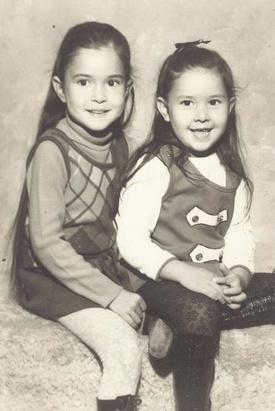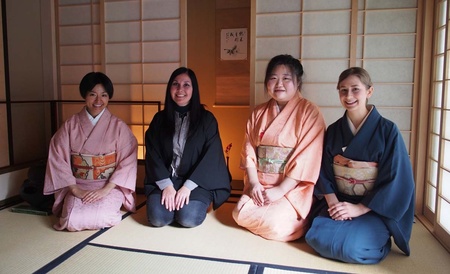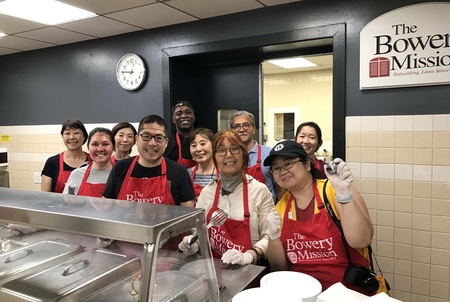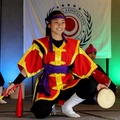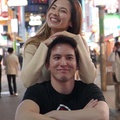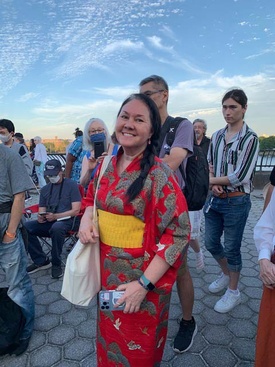
As the founder and editor-in-chief of JapanCulture•NYC, an English-language resource for Japanese culture and life in New York City, Susan Miyagi McCormac is busy attending Japanese cultural events, trying Japanese restaurants and shops, and participating in Japanese organizations, while also fully engaged with her work as a freelance graphics operator for live, televised sporting events with the YES network and other television networks. (A graphics operator organizes and operates computer-driven, on-screen graphics during live shows and events.)
Personal Geography: An Early Childhood in Many Places, Growing Up in North Carolina, and Settling in New York City
McCormac’s mother is originally from a small Okinawan village and her father was a North Carolinian of Scottish descent. Due to her father’s career in the U.S. Army, she spent her early childhood moving from place to place.
“I was born on an Army base in Fort Lee, Virginia. While my father was in the Army, we moved to Virginia, Texas, Okinawa (with my mother and sister while my father served his tour of duty in Vietnam), back to Virginia, and Germany,” she explained.
“My father retired when I was seven and we left Germany. We then settled in his home state of North Carolina, where I lived until age 21. He chose the small town of Hope Mills because of its proximity to Fort Bragg. My father died in 1993, and my mother and sister still live in Hope Mills.”
Describing her childhood as “very white American,” she added, “North Carolina wasn’t exactly a hotbed of Japanese culture in the 1970s and 80s.” Her mother felt compelled to speak only English after she got her U.S. citizenship and her father did not learn Japanese, so English became the language spoken at home. There was no Japanese weekend school and no other Japanese people nearby or at school.“As a family we didn’t follow any Japanese traditions during holidays. The only tradition I remember was my mother setting the table for her mother 49 days after her funeral, which is a Shinto ritual. I thought it was cool (I was ten years old), but I never asked my mother about it,” she recounted.
In 1990 when McCormac graduated from the University of North Carolina with a degree in communications, she moved to Richmond, Virginia, to work at a television station.
“I did basic production work: ran camera and audio, worked as a graphics operator, and eventually became a technical director and director. What I loved the most was typing graphics, and that turned into my career in live sports television.”
After six years in Richmond, she moved to Boston to work at a small TV station. She moved to New York City in 2000 and has been there ever since.
What generation Okinawan American do you consider yourself?
“I consider myself a Nisei, second-generation Okinawan American.”
What does “Nikkei” mean to you? Do you identify as “Nikkei”?
“This is an interesting question because I don’t use the term Nikkei often, and I feel that it’s more of a West Coast thing than an East Coast thing. (That’s probably not true.) So no, I don’t think I identify as Nikkei. To me, Nikkei refers to Japanese Americans in the early days of immigration to the U.S., and I’ve always thought of it as an ‘old’ or historic term.
“When I first started reading the content on the Discover Nikkei1 website was actually the first time I contemplated the term Nikkei.”
What inspired you to start JapanCulture•NYC?
“When blogging first became a thing, I started to write about my experiences in New York. This was in 2006. Although I named my blog ShrineCastle, the literal English translation of my mother’s maiden name, Miyagi, I wrote about everything from my job to watching my alma mater play basketball on TV to events I attended at Japan Society.
“After a couple of years of writing about Japanese events after I attended them, I thought, ‘Wouldn’t it be nice if I told people about these events before they happened so that maybe they could go, too?’ In 2009, I created the title of ‘NY Japanese Culture Examiner’ for the website Examiner.com and started covering events at Japan Society and anywhere else I could find them.”
During this stint, she began to understand what a “content farm” was and became dissatisfied with the clicks-for-pennies system of Examiner. She noted, “At this point, I felt that the best thing to do was to create my own website. In 2011, JapanCulture•NYC.com was born!”
How do you keep up with all the Japanese and Japanese American events happening in New York City?
“Throughout my twelve years of running JapanCulture•NYC, I have developed strong relationships with many Japanese and Japanese American organizations in New York, such as Japan Society and the Japanese Consulate, as well as public relations firms for restaurants, filmmakers, and artists. They’ve asked me to promote their events and have invited me to attend as a member of the media. My involvement on the boards of The Japanese American Association of New York and JETAANY (Japanese Exchange and Teaching Program Alumni Association of New York) has given me exposure to their fundraisers, which I happily promote on my website.
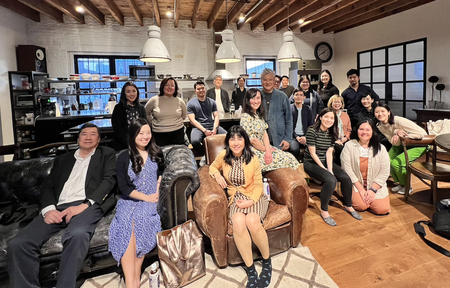
“Also, I have many creative friends who perform in dramatic productions or have concerts. Social media is a great resource for events as well. People often find JapanCulture•NYC through online searches and ask me to promote their events. It’s getting more difficult to keep up with these events because there are so many things happening at once!”
JapanCulture•NYC has recently launched new membership and sponsorship programs. What do you hope to achieve with these new initiatives?
“It’s been twelve years since I launched JapanCulture•NYC as an online information center for the Japanese and Japanese American community. I felt it was time to increase the value of the website to readers, so I added new membership and sponsorship programs. I look at this as a way of creating another layer of community and giving people another way to connect.”
Membership perks will include special insights into Japanese culture, special offers, advance notice to events, and discounts. Sponsors will receive more exposure to a targeted audience that is eager for information on fundraisers, concerts, traditional and contemporary theater and dance performances, film festivals, and sporting events.
McCormac continued, “My dream is to be able to do this full time. Japanese culture in New York has exploded so much in the past twelve years that I can’t do my ‘day job’ and also attend all of these events. As the community continues to grow, I want to help the businesses and creatives thrive and receive the organic marketing and promotion that they deserve.”
How does your identity as a Nikkei inform your work for JapanCulture•NYC?
“My Nisei/Nikkei identity informs practically everything I do for JapanCulture•NYC. Writing about events deepens my understanding of the culture and opens new avenues of learning. When something appears in my inbox about an unfamiliar aspect of Japanese culture, I research it. I can’t attend every event that I post, but I try! And when I do attend, I learn something new. It can be as simple as learning one new vocabulary word or as deep as understanding a historic time that was tragic for a specific group.”
“I’m so happy as a Japanese American to be part of this Japanese cultural community,” McCormac explained. “I think I feel this passion because I spent the first 30 years of my life not really caring about my Japanese-Okinawan heritage. Perhaps I go a little overboard now, but I shop at Japanese stores; eat Japanese food; wear clothing, makeup, manicures, and jewelry made by Japanese people; listen to Japanese musicians; look at art by Japanese artists at galleries that focus on Japanese art. Practically every aspect of my life is informed by Japanese culture. Then I pour this passion and knowledge into my website and social media.”
What are some other ways you’re involved with the Japanese and Japanese American community in the New York metro area?
“I’m a Vice President of The Japanese American Association of New York and the chair of its Sakura Matsuri committee. In 2020 I was one of the recipients of JAA’s Community Leadership Award for my role in coordinating Project Bento, an initiative through which volunteers delivered bento to homebound seniors in the Japanese and Japanese American community during the COVID lockdown here. I am also on the New York regional steering committee of the U.S.-Japan Council and on the board of JETAANY (Japanese Exchange and Teaching Program Alumni Association of New York).”
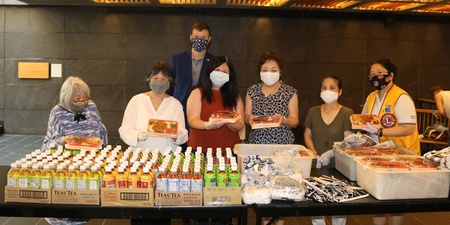
In addition to JapanCulture•NYC, you are busy with your “day job” as a freelance graphics operator for live, televised sporting events with the YES network and other sports broadcasting networks. How did you develop a passion for baseball?

“My passion for baseball developed from watching the Atlanta Braves on TV with my father. When I was around twelve years old, we finally got cable. One night I wandered into the living room and saw the Braves on TV. One look at Dale Murphy’s face, and I was hooked!” (Dale Murphy was an All-Star MVP for the Atlanta Braves, 1976-1990. He also played for the Philadelphia Phillies and Colorado Rockies.)
How did that early passion evolve into a professional career in sports television?
“Growing up in North Carolina in the 1970s and ‘80s, I was surrounded by the best college sports, plus Braves baseball. It was also a great era for sitcoms, and I devoured Happy Days, Laverne & Shirley, WKRP in Cincinnati, Family Ties, and many more. By high school, I wanted to write for sitcoms, which is why I majored in communications at University of North Carolina. Watching sports on TV made me curious about the production aspect.
“While I interned at a TV station in Fayetteville, North Carolina, I worked on a few broadcasts of the Durham Bulls, which at the time was Atlanta’s double-A affiliate. I started leaning toward a possible career in sports television. After graduation, I stayed on the East Coast and found jobs at TV stations that televised sporting events.
“In Richmond, Virginia, I worked on golf tournaments and a few Richmond Braves (Atlanta’s triple-A affiliate in the ‘90s) games. In Boston, I worked on the pre- and postgame shows of Red Sox games. A couple of colleagues introduced me to people at ESPN, and my freelance career began.”
What are your thoughts on American and Japanese baseball?
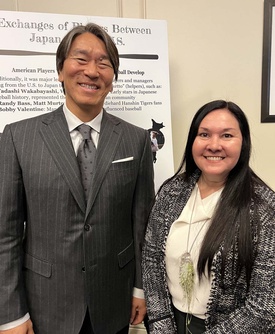
“Even though televising baseball is a job that can be tedious at times, I love the game. Baseball in North America is the standard bearer in terms of talent, for sure, but Japanese baseball isn’t far behind, as proven by stars like Ichiro Suzuki, Hideki Matsui, and Shohei Ohtani. Also, Samurai Japan defeated the U.S. team in this year’s amazing World Baseball Classic. I had the privilege of working the World Baseball Classic rounds in Tokyo this year, as well as in 2013 and 2017, a wonderful intersection of my Japanese life and my work life.”

“In my opinion, Japanese baseball games are much more entertaining to watch because of the crowds,” she continued. “Fans at NPB (Nippon Professional Baseball) games really get into it! They have specific chants for each player as well as musicians (trumpets, drums, etc.) who play in the stands. The food is great at ballparks in Japan, too. I can have okonomiyaki (savory grilled pancake) at a Carp game in Hiroshima and gyutan (grilled beef tongue) while watching the Rakuten Golden Eagles play in Sendai.”
Last year McCormac had the honor of moderating a panel discussion celebrating the 150th anniversary of baseball’s introduction to Japan. Two of the panelists were Hideki Matsui, renowned for playing for the Yomiuri Giants and the New York Yankees, and Matt Murton, who played for the Chicago Cubs and the Hanshin Tigers.
“Hearing their views on what it was like to play baseball in a different country was eye-opening. The respect Murton has for Japan was also heartwarming to hear.”
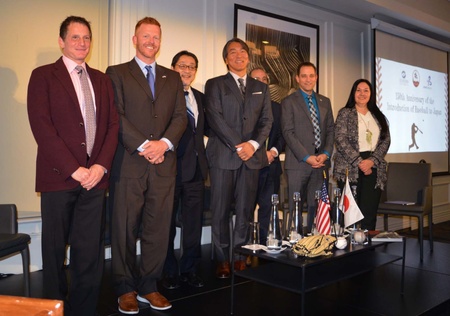
Note:
1. Click here to see a couple of Susan's Discover Nikkei articles published in the early days of JapanCulture•NY
© 2023 Karen Kawaguchi



